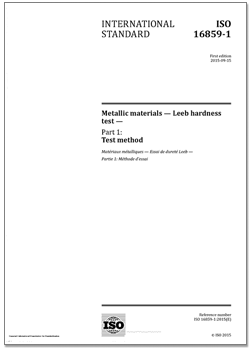INTERNATIONAL STANDARD ISO 16859-1
Metallic materials — Leeb hardness test — Part 1: Test method
ISO 16859 consists of the following parts, under the general title Metallic materials —— Leeb hardness test:
ISO 16859-1 Metallic materials — Leeb hardness test — Part 1: Test method
ISO 16859-2 Metallic materials — Leeb hardness test — Part 2: Verification and calibration of the testing devices
ISO 16859-3 Metallic materials — Leeb hardness test — Part 3: Calibration of reference test blocks
Contents
Foreword
1 Scope
2 Normative references
3 Principle
4 Symbols, abbreviated terms, and designations
5 Testing machine
6 Test piece
7 Procedure
8 Uncertainty of the results
9 Test report
10 Conversions to other hardness scales or tensile strength values
Annex A (normative) Tables of correction factors for use in tests not conducted in direction of gravity
Annex B (normative) Procedure for periodic checking of testing instrument by the user
Annex C (informative) Uncertainty of the measured Leeb hardness values
Annex D (informative) Leeb hardness testing instruments
Bibliography
1 Scope
This part of ISO 16859 covers the determination of a dynamic hardness of metallic materials using seven different Leeb scales (HLD, HLS, HLE, HLDL, HLD+15, HLC, HLG).
2 Normative references
The following documents, in whole or in part, are normatively referenced in this document and are indispensable for its application. For dated references, only the edition cited applies. For undated references, the latest edition of the referenced document (including any amendments) applies.
ISO 16859:2, Metallic materials — Leeb hardness test — Part 2: Verification and calibration of the testing devices
ISO 16859:3, Metallic materials — Leeb hardness test — Part 3: Calibration of reference test blocks
3 Principle
When testing hardness according to Leeb, a moving impact body collides at normal incidence with a surface and rebounds. The velocity of the impact body is measured before (vA) and after impact (vR). The energy amount absorbed by the test piece respectively dissipated in the test measures the dynamic Leeb hardness of the test piece. It is assumed that the impact body does not permanently deform.
The ratio of the impact and rebound velocity values gives the coefficient of restitution for the impact configuration and energy used. This coefficient represents the proportion of initial kinetic energy returned to the impact body within the contact time of the impact.
在线阅读 免费下载







